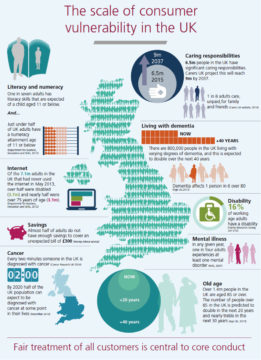HCID 2018: beyond the screen
Key takeaways from HCID 2018, with insights on taking interactions beyond the screen
...
Key takeaways from HCID 2018, with insights on taking interactions beyond the screen
...

Each year, City University of London hosts its Human Computer Interaction Design (HCID) Open Day . The theme of HCID 2019 was ‘Design for Good’.
Here are 5 key takeaways from this year’s conference, on how design can positively impact society; designing for inclusion; and the moral implications of design.
There are numerous considerations when designing for older audiences, particularly as older people are often less accustomed to digital interfaces. Flat design is a minimalist style of design that removes many of the design elements that give the illusion of three-dimensional shapes, and has become increasingly common.
However, older audiences are not as familiar with soft interfaces and so benefit more from three-dimensional, real world visual cues. For example, a button on a website should look pressable, so that it is obvious that it can be pressed. Providing 3D shadowing on the design of the button can aid this.
James Gadsby-Peet – HCID 2019 speaker profile

However, it’s important to also bear in mind ‘anti-persona’ users who are not your target audience but may still use your product; just not in the way it was intended. This could include users who have bad intentions when using your product. For example, using it to commit fraud or identity theft. Including these types of personas in your design process will help you to understand all your users, the ones you expect and want, as well as other users who you need to consider to protect your product and possibly protect other existing users.
Sam Hooper – HCID 2019 speaker profile

It is common in UX design to hear that good UX means making things easy for users. However, when designing for users in vulnerable circumstances, this is not always the case. For example, making it easy to take financial risks (such as gambling, taking out a loan, or spending large amounts of money) could put users at financial risk.
Inserting positive friction in such cases is therefore responsible UX design which prioritises the overall wellbeing of the user. A good example of positive friction is from Monzo, who allow you to block all gambling payments: the only way to remove the block is to talk to someone from Monzo and then wait 48 hours.
David Caldwell – HCID 2019 speaker profile
“A picture is worth a thousand words.” Visual cues can be helpful for everyone to understand certain concepts or instructions and in many instances, they can be clearer than following textual instructions. However, this is even more crucial for users with communication difficulties or dyslexia.
Including visual cues within research sessions makes instructions and concepts easier to understand for participants with communication difficulties (as well as everyone else)!
Alex Taylor – HCID 2019 speaker profile

James Gadsby-Peet – HCID 2019 speaker profile
Usability testing of tablet-first design: client case study
Learn how we delivered business critical usability testing when Amadeus committed to implementing a tablet-first design approach.
Hopefully our takeaways from the City University’s HCID 2019 event has given you something to think about. If you’d like to chat about it more or would like to discuss anything you might be working on at the moment, we’d love to hear from you. We are experienced in using a wide range of research and design methodologies to help you improve your users’ experience.

Key takeaways from HCID 2018, with insights on taking interactions beyond the screen
...
Key takeaways from HCID 2018, with insights on taking interactions beyond the screen
...
How we helped Just Eat to establish a usability baseline to drive improved UX...
How we helped Just Eat to establish a usability baseline to drive improved UX...
Discover what the demographic shift means for the role of UX in product design...
Discover what the demographic shift means for the role of UX in product design...